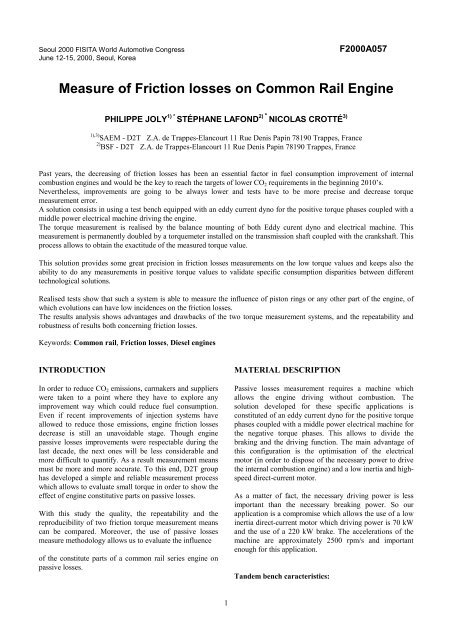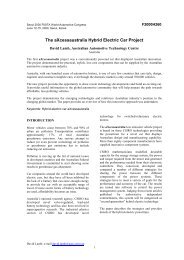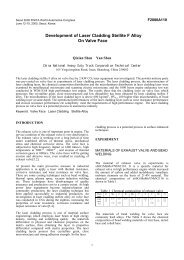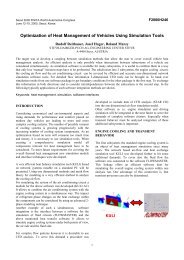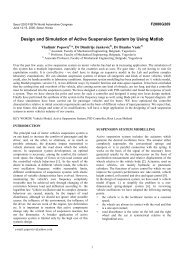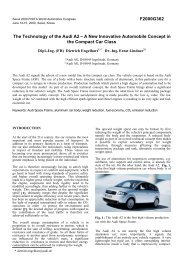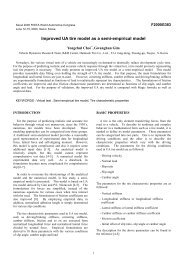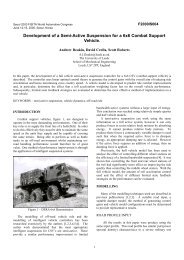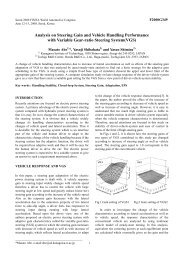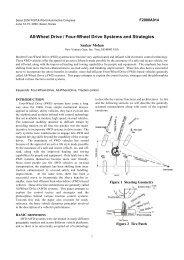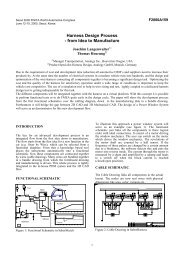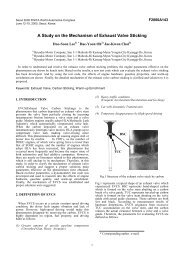Measure of Friction losses on Common Rail Engine
Measure of Friction losses on Common Rail Engine
Measure of Friction losses on Common Rail Engine
Create successful ePaper yourself
Turn your PDF publications into a flip-book with our unique Google optimized e-Paper software.
Seoul 2000 FISITA World Automotive C<strong>on</strong>gressJune 12-15, 2000, Seoul, KoreaF2000A057<str<strong>on</strong>g>Measure</str<strong>on</strong>g> <str<strong>on</strong>g>of</str<strong>on</strong>g> <str<strong>on</strong>g>Fricti<strong>on</strong></str<strong>on</strong>g> <str<strong>on</strong>g>losses</str<strong>on</strong>g> <strong>on</strong> Comm<strong>on</strong> <strong>Rail</strong> <strong>Engine</strong>PHILIPPE JOLY 1) * STÉPHANE LAFOND 2) * NICOLAS CROTTÉ 3)1),3) SAEM - D2T Z.A. de Trappes-Elancourt 11 Rue Denis Papin 78190 Trappes, France2) BSF - D2T Z.A. de Trappes-Elancourt 11 Rue Denis Papin 78190 Trappes, FrancePast years, the decreasing <str<strong>on</strong>g>of</str<strong>on</strong>g> fricti<strong>on</strong> <str<strong>on</strong>g>losses</str<strong>on</strong>g> has been an essential factor in fuel c<strong>on</strong>sumpti<strong>on</strong> improvement <str<strong>on</strong>g>of</str<strong>on</strong>g> internalcombusti<strong>on</strong> engines and would be the key to reach the targets <str<strong>on</strong>g>of</str<strong>on</strong>g> lower CO 2 requirements in the beginning 2010’s.Nevertheless, improvements are going to be always lower and tests have to be more precise and decrease torquemeasurement error.A soluti<strong>on</strong> c<strong>on</strong>sists in using a test bench equipped with an eddy current dyno for the positive torque phases coupled with amiddle power electrical machine driving the engine.The torque measurement is realised by the balance mounting <str<strong>on</strong>g>of</str<strong>on</strong>g> both Eddy curent dyno and electrical machine. Thismeasurement is permanently doubled by a torquemeter installed <strong>on</strong> the transmissi<strong>on</strong> shaft coupled with the crankshaft. Thisprocess allows to obtain the exactitude <str<strong>on</strong>g>of</str<strong>on</strong>g> the measured torque value.This soluti<strong>on</strong> provides some great precisi<strong>on</strong> in fricti<strong>on</strong> <str<strong>on</strong>g>losses</str<strong>on</strong>g> measurements <strong>on</strong> the low torque values and keeps also theability to do any measurements in positive torque values to validate specific c<strong>on</strong>sumpti<strong>on</strong> disparities between differenttechnological soluti<strong>on</strong>s.Realised tests show that such a system is able to measure the influence <str<strong>on</strong>g>of</str<strong>on</strong>g> pist<strong>on</strong> rings or any other part <str<strong>on</strong>g>of</str<strong>on</strong>g> the engine, <str<strong>on</strong>g>of</str<strong>on</strong>g>which evoluti<strong>on</strong>s can have low incidences <strong>on</strong> the fricti<strong>on</strong> <str<strong>on</strong>g>losses</str<strong>on</strong>g>.The results analysis shows advantages and drawbacks <str<strong>on</strong>g>of</str<strong>on</strong>g> the two torque measurement systems, and the repeatability androbustness <str<strong>on</strong>g>of</str<strong>on</strong>g> results both c<strong>on</strong>cerning fricti<strong>on</strong> <str<strong>on</strong>g>losses</str<strong>on</strong>g>.Keywords: Comm<strong>on</strong> rail, <str<strong>on</strong>g>Fricti<strong>on</strong></str<strong>on</strong>g> <str<strong>on</strong>g>losses</str<strong>on</strong>g>, Diesel enginesINTRODUCTIONIn order to reduce CO 2 emissi<strong>on</strong>s, carmakers and supplierswere taken to a point where they have to explore anyimprovement way which could reduce fuel c<strong>on</strong>sumpti<strong>on</strong>.Even if recent improvements <str<strong>on</strong>g>of</str<strong>on</strong>g> injecti<strong>on</strong> systems haveallowed to reduce those emissi<strong>on</strong>s, engine fricti<strong>on</strong> <str<strong>on</strong>g>losses</str<strong>on</strong>g>decrease is still an unavoidable stage. Though enginepassive <str<strong>on</strong>g>losses</str<strong>on</strong>g> improvements were respectable during thelast decade, the next <strong>on</strong>es will be less c<strong>on</strong>siderable andmore difficult to quantify. As a result measurement meansmust be more and more accurate. To this end, D2T grouphas developed a simple and reliable measurement processwhich allows to evaluate small torque in order to show theeffect <str<strong>on</strong>g>of</str<strong>on</strong>g> engine c<strong>on</strong>stitutive parts <strong>on</strong> passive <str<strong>on</strong>g>losses</str<strong>on</strong>g>.With this study the quality, the repeatability and thereproducibility <str<strong>on</strong>g>of</str<strong>on</strong>g> two fricti<strong>on</strong> torque measurement meanscan be compared. Moreover, the use <str<strong>on</strong>g>of</str<strong>on</strong>g> passive <str<strong>on</strong>g>losses</str<strong>on</strong>g>measure methodology allows us to evaluate the influence<str<strong>on</strong>g>of</str<strong>on</strong>g> the c<strong>on</strong>stitute parts <str<strong>on</strong>g>of</str<strong>on</strong>g> a comm<strong>on</strong> rail series engine <strong>on</strong>passive <str<strong>on</strong>g>losses</str<strong>on</strong>g>.MATERIAL DESCRIPTIONPassive <str<strong>on</strong>g>losses</str<strong>on</strong>g> measurement requires a machine whichallows the engine driving without combusti<strong>on</strong>. Thesoluti<strong>on</strong> developed for these specific applicati<strong>on</strong>s isc<strong>on</strong>stituted <str<strong>on</strong>g>of</str<strong>on</strong>g> an eddy current dyno for the positive torquephases coupled with a middle power electrical machine forthe negative torque phases. This allows to divide thebraking and the driving functi<strong>on</strong>. The main advantage <str<strong>on</strong>g>of</str<strong>on</strong>g>this c<strong>on</strong>figurati<strong>on</strong> is the optimisati<strong>on</strong> <str<strong>on</strong>g>of</str<strong>on</strong>g> the electricalmotor (in order to dispose <str<strong>on</strong>g>of</str<strong>on</strong>g> the necessary power to drivethe internal combusti<strong>on</strong> engine) and a low inertia and highspeeddirect-current motor.As a matter <str<strong>on</strong>g>of</str<strong>on</strong>g> fact, the necessary driving power is lessimportant than the necessary breaking power. So ourapplicati<strong>on</strong> is a compromise which allows the use <str<strong>on</strong>g>of</str<strong>on</strong>g> a lowinertia direct-current motor which driving power is 70 kWand the use <str<strong>on</strong>g>of</str<strong>on</strong>g> a 220 kW brake. The accelerati<strong>on</strong>s <str<strong>on</strong>g>of</str<strong>on</strong>g> themachine are approximately 2500 rpm/s and importantenough for this applicati<strong>on</strong>.Tandem bench caracteristics:1
Inertia: 0.35 m 2 kgBraking torque : 610 N.mBraking power : 220 kWDriving torque : 133 N.m (C<strong>on</strong>stant up to 5000rpm)Driving power : 70 kWMaximum speed : 7500 rpmA torquemeter (cramp pattern without ball-bearing) is set<strong>on</strong> the dumb-bell shaft between the engine and the eddycurrent dyno in order to establish the correlati<strong>on</strong> betweentorque measures.heated with c<strong>on</strong>diti<strong>on</strong>ers set up in the engine test bench.Once temperature choice made, a two minutes stabilityperiod is necessary before the acquisiti<strong>on</strong> <str<strong>on</strong>g>of</str<strong>on</strong>g> the workingc<strong>on</strong>diti<strong>on</strong>s parameters.Past tests showed a significant influence <str<strong>on</strong>g>of</str<strong>on</strong>g> the oil level.To free this parameter, the engine oil quantity is fixed at 4liters and the oil grade is 15W40 whatever the test (Fig.2).6.565.5Oil temperature influence <strong>on</strong> the Mean fricti<strong>on</strong> pressureTemperature difference 25/80Temperature difference 80/110Oil at 298캩Oil at 353캩Oil at 383캩403530525M.F.P. (bar)4.5420Difference (%)153.53102.552R□ ime 1000 1250 1500 1750 2000 2250 2500 2750 3000 3250 3500 3750 4000 4250<strong>Engine</strong> speed (rpm)0Fig.1Grade oil influence <strong>on</strong> the Mean <str<strong>on</strong>g>Fricti<strong>on</strong></str<strong>on</strong>g> Pressure54.03.53.0<str<strong>on</strong>g>Fricti<strong>on</strong></str<strong>on</strong>g> <str<strong>on</strong>g>losses</str<strong>on</strong>g> measurement requires engine fluid heaterfor oil or engine cooling fluid. The system designed forthis applicati<strong>on</strong> is made <str<strong>on</strong>g>of</str<strong>on</strong>g> heating resistors set inpressurised tanks. The resistors <str<strong>on</strong>g>of</str<strong>on</strong>g> the oil circuit areequipped with temperature probe set <strong>on</strong> the superficialfaces in order to avoid any risks <str<strong>on</strong>g>of</str<strong>on</strong>g> oil destructi<strong>on</strong>. Anengine fluids external circulati<strong>on</strong> is unavoidable in order totest the engine without these elements. This functi<strong>on</strong> isperformed by circulati<strong>on</strong> pumps equipped with frequencyvariator which can be short-circuited if the engine partsmust be used. The heat exchangers <str<strong>on</strong>g>of</str<strong>on</strong>g> oil and enginecooling liquids are set in the bench. Both temperatures andcooling fluid flow rate can be c<strong>on</strong>trolled.Oil and cooling fluid caracteristics :Heating power <str<strong>on</strong>g>of</str<strong>on</strong>g> cooling fluid circuit : 24 kWHeating power <str<strong>on</strong>g>of</str<strong>on</strong>g> oil circuit : 12 kWMaximum oil temperature : 418 KMaximum cooling fluid temperature : 398 KMaximum oil pressure : 6 barTESTING METHODOLOGYBecause <str<strong>on</strong>g>of</str<strong>on</strong>g> the b<strong>on</strong>d between passive <str<strong>on</strong>g>losses</str<strong>on</strong>g> and oilviscosity, engine temperature c<strong>on</strong>diti<strong>on</strong>ing is a crucialpoint for the validity measure before any acquisiti<strong>on</strong> (Fig1).In order to free this influence, the temperature <str<strong>on</strong>g>of</str<strong>on</strong>g> bothengine cooling system liquids and oil is c<strong>on</strong>trolled andM.F.P. (bar)43210800 1000 1500 2000 2500 3000 3500 4000 4500<strong>Engine</strong> speed (rpm)Fig.2Gain: 10W40 / 15W40Working c<strong>on</strong>diti<strong>on</strong> parameters are computer recorded inthe test bench during 20 sec<strong>on</strong>ds and then averaged. Testbench operators can evaluate the validity <str<strong>on</strong>g>of</str<strong>on</strong>g> their measurewith torque or engine speed stability criteri<strong>on</strong>s.For each working c<strong>on</strong>diti<strong>on</strong>, 3 measures is taken by theoperating system and the test bench acquisiti<strong>on</strong> system.With stability criteri<strong>on</strong>s, these measures are statisticallyprocessed in order to determine the best point.For a determined engine c<strong>on</strong>figurati<strong>on</strong>, passive <str<strong>on</strong>g>losses</str<strong>on</strong>g> arealways measured in terms <str<strong>on</strong>g>of</str<strong>on</strong>g> engine speed from high speedto idling speed in order to hold the thermal c<strong>on</strong>diti<strong>on</strong>s inan easier way.Before any new test, the bench operator checks the zerotorque in order to detect a possible drift <str<strong>on</strong>g>of</str<strong>on</strong>g> the sensor orthe measurement channel.Calibrati<strong>on</strong> is checked daily with calibrati<strong>on</strong> arm andsprung masses for the brake and the machine and with anelectrical system for the torquemeter set <strong>on</strong> the dumb-bellshaft.15W4010W402.52.01.51.00.50.0-0.5-1.0-1.5-2.0-2.5-3.0-3.5-4.0-4.5-5.0gain (%)2
MEASUREMENT QUALITY.The torque measurement incertitude is known (+/- 0.25N.m for the balanced machine and +/- 0.2 N.m for thetorquemeter) for both methods. Repeatability dubiousnesswas determined in order to evaluate their capability tomeasure passive <str<strong>on</strong>g>losses</str<strong>on</strong>g>.Comparais<strong>on</strong> des incertitudes de r□ □□abilit□ □ entre le m<strong>on</strong>tage en balance et la mesure au couplem□ reIncertitude de r□ □abilit□□95% du m<strong>on</strong>tage en balance : +/- 0.31 N.mIncertitude de r□ □abilit□□95% du m<strong>on</strong>tage avec couplem□ re : +/- 0.25 N.mSigma m<strong>on</strong>tage avec couple-□Sigma m<strong>on</strong>tage en balance0-0.10.1Repeatability <str<strong>on</strong>g>of</str<strong>on</strong>g> measurement means and testsThis dubiousness is statistically determined by calculati<strong>on</strong><str<strong>on</strong>g>of</str<strong>on</strong>g> differences between two passives <str<strong>on</strong>g>losses</str<strong>on</strong>g> curvesestablished with the same engine c<strong>on</strong>figurati<strong>on</strong> (6 differentc<strong>on</strong>figurati<strong>on</strong>s were tested) (Fig.3).-0.5-0.4-0.3-0.2M<strong>on</strong>tage en balanceCouple-m□ re0.20.30.40.5Fig.4Torque (N.m)25Repeatability <str<strong>on</strong>g>of</str<strong>on</strong>g> torque measurmentDiff□ ence(N.m)0.30Reproducibility <str<strong>on</strong>g>of</str<strong>on</strong>g> measurement means and tests0.20200.10150.0010-0.105-0.200-0.30800 1000 1200 1400 1600 1800 2000 2200 2400 2600 2800 3000 3200 3400 3600 3800 4000 4200 4400<strong>Engine</strong> speed (tr/min)Essai 1 Essai 1 Essai 6 Essai 6 Ecart 1 Ecart 6The reproducibility <str<strong>on</strong>g>of</str<strong>on</strong>g> a test is determined with differentengines supposed equivalent except the dispersi<strong>on</strong> <str<strong>on</strong>g>of</str<strong>on</strong>g>engine parts machining , tightening torque and thicknessseals.During our tests, this method has not been employed.Nevertheless, to reinforce the credibility <str<strong>on</strong>g>of</str<strong>on</strong>g> our measures,we compare the fricti<strong>on</strong> <str<strong>on</strong>g>losses</str<strong>on</strong>g> <str<strong>on</strong>g>of</str<strong>on</strong>g> engines before and aftertheir analyze. The figure 5 shows the results and thecalculated dubiousness.Fig.380Reproducibility <str<strong>on</strong>g>of</str<strong>on</strong>g> torque measurment0.4Let A be a sample :A = ( a , a2,... a i,... a )Let a' be the mean value1 nTorque (N;m)70605040Reproducibility at 95 % : 0.4 N.m0.30.20.10-0.1-0.2Difference (N.m)30-0.3a'=n∑ a ii=1Let σ be the standard deviati<strong>on</strong> :σ =n∑i=1( a'−ai)n −1So the dubiousness repeatability at 95% is +/- 2 σ.The figure 4 shows the distributi<strong>on</strong> <str<strong>on</strong>g>of</str<strong>on</strong>g> the differencesbetween the measures. We can determine that thedubiousness <str<strong>on</strong>g>of</str<strong>on</strong>g> the balanced machine is +/-0.43 Nm andthe torquemeter is +/-0.3 Nm.220500 1000 1500 2000 2500 3000 3500 4000 4500<strong>Engine</strong> Speed (tr/min)Begin analyse End analyse DifferenceFig.5In c<strong>on</strong>siderati<strong>on</strong> <str<strong>on</strong>g>of</str<strong>on</strong>g> our repeatability results with the twomeasurement means, we have chosen the torquemeter. Itsmost positive aspect is that the measure is absolutelyindependent <str<strong>on</strong>g>of</str<strong>on</strong>g> the possible mechanical problems <str<strong>on</strong>g>of</str<strong>on</strong>g> themachine or the brake.RESULTS AND DISCUSSIONThe engine tested and which results are presented is a 2liters Comm<strong>on</strong> <strong>Rail</strong> engine. These results are compared-0.43
with another direct injecti<strong>on</strong> engine equipped with amechanical injecti<strong>on</strong> pump, and an indirect injecti<strong>on</strong>engine.4.54<str<strong>on</strong>g>Fricti<strong>on</strong></str<strong>on</strong>g> <str<strong>on</strong>g>losses</str<strong>on</strong>g> comparais<strong>on</strong>IDI Complete versi<strong>on</strong>HDI Complete versi<strong>on</strong>The wearing period was established with a 15 hours cycle<str<strong>on</strong>g>of</str<strong>on</strong>g> different engine speed and load. This cycle wasrepeated until the stability <str<strong>on</strong>g>of</str<strong>on</strong>g> fuel c<strong>on</strong>sumpti<strong>on</strong> and fricti<strong>on</strong><str<strong>on</strong>g>losses</str<strong>on</strong>g>. This engine was c<strong>on</strong>sidered stabilized after 100hours.The stage by stage cutting up <str<strong>on</strong>g>of</str<strong>on</strong>g> the Comm<strong>on</strong> <strong>Rail</strong> engineshows the influence <str<strong>on</strong>g>of</str<strong>on</strong>g> the different c<strong>on</strong>stitutive parts. Thefricti<strong>on</strong> <str<strong>on</strong>g>losses</str<strong>on</strong>g> repartiti<strong>on</strong> is the following:• The moving parts represent 20 % <str<strong>on</strong>g>of</str<strong>on</strong>g> the global fricti<strong>on</strong><str<strong>on</strong>g>losses</str<strong>on</strong>g> and 0.5 % for crankshaft.• The cylinder head, the pumping and the timingrepresent 50 %• The intake and exhaust <str<strong>on</strong>g>losses</str<strong>on</strong>g> represent 20 % and18 % because <str<strong>on</strong>g>of</str<strong>on</strong>g> the turbocharger and the exhaustaerodynamic <str<strong>on</strong>g>losses</str<strong>on</strong>g>• Balance is due to accessories.To be more precise, the tests show that the fricti<strong>on</strong> torquegenerated by the top ring can grow up to 2N.m and that itis resp<strong>on</strong>sible for 3% <str<strong>on</strong>g>of</str<strong>on</strong>g> the global fricti<strong>on</strong> <str<strong>on</strong>g>losses</str<strong>on</strong>g>.Comparis<strong>on</strong> between direct injecti<strong>on</strong>, comm<strong>on</strong>rail and indirect diesel engineBecause <str<strong>on</strong>g>of</str<strong>on</strong>g> the accessories and engine parameterdifferences, the comparis<strong>on</strong> between these 3 diesel enginetechnologies is not easy. Nethertheless tests show thatsome implicit rules can be drawn from results.All the results go to prove the importance <str<strong>on</strong>g>of</str<strong>on</strong>g> the <str<strong>on</strong>g>losses</str<strong>on</strong>g> <str<strong>on</strong>g>of</str<strong>on</strong>g>charge generated by swirl formati<strong>on</strong> in a direct injecti<strong>on</strong>diesel engine (Fig. 6). Intake <str<strong>on</strong>g>losses</str<strong>on</strong>g> <str<strong>on</strong>g>of</str<strong>on</strong>g> charge grow up to20% less at 4000 rpm for an indirect injecti<strong>on</strong> engine thanfor a direct <strong>on</strong>e. Even if the difference between the 2 directinjecti<strong>on</strong> engine is not huge, <strong>on</strong>e can suppose that higherinjecti<strong>on</strong> pressure could decrease the swirl requirements.That could be why the Comm<strong>on</strong> <strong>Rail</strong> pumping <str<strong>on</strong>g>losses</str<strong>on</strong>g> areless important than the DI <strong>on</strong>es. But this result should beproved by other experiments, especially with a swirlmeasurement in these cylinder heads.As far as the moving parts are c<strong>on</strong>cerned, differencesmeasured cannot show any hierarchy between Comm<strong>on</strong><strong>Rail</strong> and DI engines. Yet the fricti<strong>on</strong> <str<strong>on</strong>g>losses</str<strong>on</strong>g> due to themoving parts are less important for a direct injecti<strong>on</strong>engine than for an indirect <strong>on</strong>e.The working principle <str<strong>on</strong>g>of</str<strong>on</strong>g> a direct injecti<strong>on</strong> engine inducesthermal stresses that have drawn pist<strong>on</strong>, rod, andcrankshaft to be heavier. As a result, their fricti<strong>on</strong> <str<strong>on</strong>g>losses</str<strong>on</strong>g>should be more important. Despite the indirect injecti<strong>on</strong>engine generati<strong>on</strong> is older than the direct <strong>on</strong>e, so <strong>on</strong>e canthink than technological progress have taken the level <str<strong>on</strong>g>of</str<strong>on</strong>g>this trend.M.F.P. (bar)3.532.521.510.50CONCLUSION1500 <strong>Engine</strong> speed (rpm)4000Fig. 6DI Complete veris<strong>on</strong>IDI pumping+intake+exhaustHDI pumping+intake+exhaustDI pumping+intake+exhaustIDI cranckshaftHDI cranckshaftDI cranckshaftIDI pist<strong>on</strong>+rod+ringsHDI pist<strong>on</strong>+rod+ringsDI pist<strong>on</strong>+rod+ringsThe study driven <strong>on</strong> this engine has given data c<strong>on</strong>sideringthe choices and the testing means limits. The differencesmeasured during the stage by stage cutting up are sensitiveenough so that experiment planning is not necessary tocompare an engine to similar <strong>on</strong>es. Nevertheless, if the aim<str<strong>on</strong>g>of</str<strong>on</strong>g> the study is to evaluate mechanical <str<strong>on</strong>g>losses</str<strong>on</strong>g>, which aresmaller than the incertitude <str<strong>on</strong>g>of</str<strong>on</strong>g> repeatability orreproducibility, an experiment planning is unavoidable.Yet other ways can be explored such as amplificati<strong>on</strong> <str<strong>on</strong>g>of</str<strong>on</strong>g>phenomen<strong>on</strong>. For example, in order to compare thefricti<strong>on</strong> <str<strong>on</strong>g>losses</str<strong>on</strong>g> generated by different top ring geometry, itis possible to increase the engine speed <str<strong>on</strong>g>of</str<strong>on</strong>g> the test or to usea special pist<strong>on</strong> equipped with several similar top rings. Acomplementary soluti<strong>on</strong> could be the use <str<strong>on</strong>g>of</str<strong>on</strong>g> a torquemeterwhich sensibility is compatible with the measure.Oil and fuel c<strong>on</strong>sumpti<strong>on</strong> reducti<strong>on</strong> and the correlati<strong>on</strong>with fricti<strong>on</strong> loss simulati<strong>on</strong>s will need furtherinvestigati<strong>on</strong>s in top ring geometry. To this end, this kind<str<strong>on</strong>g>of</str<strong>on</strong>g> testing bench is appropriated to keep abreast <str<strong>on</strong>g>of</str<strong>on</strong>g> thatdomain.REFERENCES[1] Heywood.J.B – 930p 1988a Mc Graw-Hill – NewYork. Internal combusti<strong>on</strong> enginefundamentals[2] Young Cheng – SAE technical paper 982686 - The <strong>on</strong>line estimati<strong>on</strong> <str<strong>on</strong>g>of</str<strong>on</strong>g> the power performance and mechanical<str<strong>on</strong>g>losses</str<strong>on</strong>g> <str<strong>on</strong>g>of</str<strong>on</strong>g> engines.4


